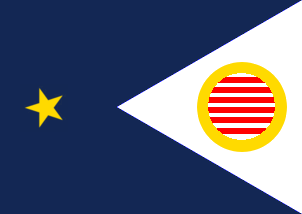The Spanish 'Jota'
CALL = JESUS
"REMOTELY CONTROLLED"

English speakers don't use this sound but can easily make it. This sound is popular in Spanish and sounds like a cat hissing while making the letter 'H' sound. The Spanish 'J' can be found in the Spanish words:
Jugar (play)
Juan (John)
Jesus (Hey-Zeus with a cat hiss on 'H' in Hey)
'Enye' or the Spanish N with a tilda on it
CALL = PINATA
"PARTY SOON"

This sound is used in English but ignored as a separate sound. Think of the word 'Manual.' The 'n' in 'Manual' dose not sound like a regular 'n.' Perhaps the most popular word in Spanish recognizable to world is 'MANANA.' The first 'N' of 'MANANA' uses this flag - manana means tomorrow. As you can see this flag is based on the international maritime code for 'N' but with red and black.
The Soft TH
CALL = THIMBLE
"REQUESTING POLICE PROTECTION"
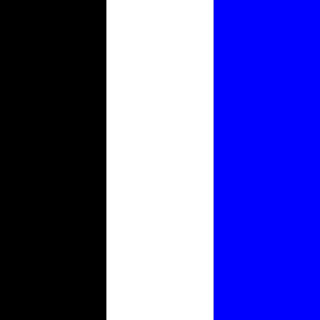
The 'TH' sound in English can be difficult for a foreigner to master. It is so strange that even English speakers don't notice the complexities of it.There are actually two TH sounds - a hard and soft. In Arabic they make a distinction with different letters, but in English we don't.
Link to Soft Arabic TH or Hard Arabic TH letter, and this video illustrates the differences.
This 'TH' is the soft one as can be found in thing, thick, or at the end as in sloth. This flag is based upon the international maritime code for the letter 'T.' The next flag illustrates the hard or rather vibrating 'TH' sound.
The Hard TH sound
CALL = THAT-CAT
"IMMEDIATE AIRLIFT NEEDED"
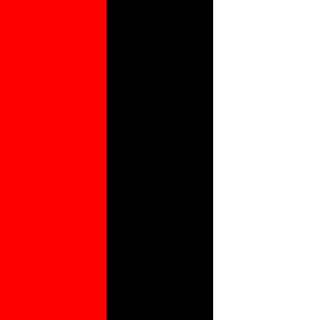
Again it is based on the international maritime code for the vertical tri-bar for the letter 'T' yet it represents the hard 'TH' sound with a vibration like: The, Those, That, and Then. The two 'TH' sounds are like the difference between 'F' and 'V.'
'F' and 'V' are very similar. The hard 'TH' has the 'V' vibration while the soft 'TH' is like 'F' without a vibration.
The hard back throat K or Hebew Khet
like your going to hock a looger
CALL = CHUTZPAH
"TAKING ON WATER/SINKING"
Remember that thing at the back of your throat that apparently has no purpose? It may have no use in English, but other languages sometimes use it.
The uvula helps make the hocking 'K' vibration-sound. Most linguists call it a guttural sound. But it dose not involve the gut - the stuff below the esophagus. Rather it involves the back of the throat. These sounds are used in Hebrew, Arabic, Dutch, Scottish, and French. English rarely uses it, but we can easily make that sound. Click this link to see it in action.
The rolled rr of Spanish
CALL = ARROZ
"TERRORISTS IN CONTROL"
 Most English speakers have the tables finally turned on them - and making this sound is a bit of a challenge.
Most English speakers have the tables finally turned on them - and making this sound is a bit of a challenge.The design of the flag is based on a flag for 'R' - reversed by colours and doubled in crosses. Graciously it has the colours of Spain already on it.
If you liked making sound effects when you were younger, then mastering it should be no problem. Click this link on youtube to learn how to get the rolled Spanish R.
The CH sound
CALL = CHIPPER
"REQUESTING UNDERWATER SCUBA/SUB DOCKING TEAM"

This flag is based upon the international maritime code for the letter 'C' - but facing horizontal. The architects of the English Language apparently thought it'd be easier to combine two letters rather than invent a new letter - like they did in Russian. The 'Scuba Docking' flag is a sordid combo of the diver down flag of 'Alpha' and the 'US-North American' flags.
The Jacques Cousteau Sound
or Russian Zhe - looks like an Asterisk
CALL = JACQUES-COUSTEAU
"EXOTIC ANIMALS ON BOARD"
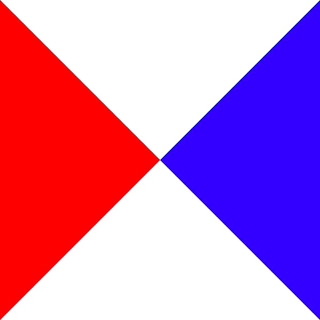 This sound is used in English, but not distinguished. In Russian and French they use this sound much more like a consonant. You can hear this sound in the name George, if you hold out the vibrating 'G' sound or better yet in 'treasure' with the letter 'S.'
This sound is used in English, but not distinguished. In Russian and French they use this sound much more like a consonant. You can hear this sound in the name George, if you hold out the vibrating 'G' sound or better yet in 'treasure' with the letter 'S.'The SH sound Flag
CALL = SUGAR
"PRISONERS IN CARGO"

Again this flag represents the 'SH' sound which has its own letter in Arabic, Hebrew, Russian, and even the mother language of all - Egyptian. Some how the Romans decided that the 'SH' sound didn't deserve its own letter.
Rather the 'S' and 'H' were married to make this sound, but sometimes 'C' can interlope with 'H' to make the 'shh' sound on occasions.
Also note 'S' by itself can sometimes make the 'SH' sound as in 'SUGAR.' We don't say 'SUE-GAR' rather we say 'SHUGER,' yet we spell it 'sugar.' See how nutty English really is!?
The NG flag
CALL =NGOW or COWTOWING
"NEED LANGUAGE TRANSLATOR"

This sound is commonly found in South East Asian languages and sounds like a mashed up 'N' and 'G.' Oddly, this sound is commonly in English, but only at the end and middle. You'd think we'd have no problem using it the beginning or have it appear a few times in a leading role?
With a little bit of practice native English Speakers can master it, since we already use it, quite a lot.
Click this link to see this 'consonant' in leading roles - as found in Thailand, China, Vietnamese, Laotian, Cambodian, Malaysian, Tagalog, and Indonesian.
The throat clicks
CALL - QIKQIOk or Q-BERT
"TOURIST VESSEL"
 This sound used is some African Languages. This is a sound little kids like to make when playing around. In the linked video it is the last click.
This sound used is some African Languages. This is a sound little kids like to make when playing around. In the linked video it is the last click.Backwards Tsi or Psi, The C-Click
CALL =CXACXAGABOR or ZSA ZSA GABOR
"U.F.O."
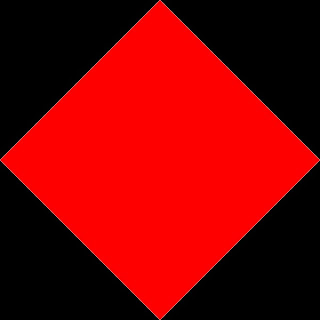
This click is sort of like a backwards psi or tsi. It is used in Central Southern Africa and in Native Mayan Languages. To make this sound click the link - it's the same video for QikQiok.
The Side Click
CALL = QIOSA - CLICK CLOCK
"U.F.I" - Unknown Floating Item

This click is best known as the horse click or something like that. To hear it and perhaps practice it follow the link above. This flag is unique in design an like a backwards "ALPHA." The tree sounds originate from the Xhosa Language.
The PSI or TSI flag
CALL = PSYCHIC
"A.I. IN CONTROL"

This flag is based upon the international maritime flag for 'S.' The PSI sound originally had its own letter in Greek - which looks like a pitchfork. But the Romans must have decided that it was a stupid looking letter. Such a shame, since the pitchfork letter is cool looking.
We English speakers use this sound a lot but it's ignored - examples of the sound can be found at the end of words like lets, pets, lips and psst. Psychic is pronounced 'TSYE-KICK.'
The Japanese R/L
CALL = LOTERRIA
"CYBORGS IN CHARGE"

In Japan there is an 'R/L' sound. It seems to be a hybrid of the 'L' and 'R' sounds. You'd then think the Japanese would have no problem distinguishing between an 'R' and 'L' sound? Wrong!
But going the other way - as a native English speaker to learn the Japanese 'R' is much easier. Much easier than rolling the Spanish RR.
The Japanese "Ra-Ri-Ru-Re-Ro" sound (click for a youtube viedo link). But going the other way - for native Japanese speakers to learn the English 'R' or 'L' is difficult. Finally note that LOTTERIA is fast food chain founded by an Japanese National who was ethnically Korean.
----------------------------------------------
When the English tried to adapt a Latin Roman Alphabet to a Germanic Language their was a wee bit of confusion on how to make it all work. To this day English Speakers oddly take pride on themselves when they master this insanely irrational language. If you have not noticed there are no Spelling Bees in Spain for good reason - the language matches up mostly with the way its supposed to sound and how it's written. This is the reason why substitute teachers and native English speakers can't read new foreign names or odd foreign words. One has to stumble many times before getting the system right - it's a cursed language.
A similar thing happened on the other side of the world in Japan. The Japanese took mainland Chinese Languages from different regions and at different times - then cluster schmucked it to their own Tungus like tongue. The result is a complex and challenging language. Subsequently native Japanese speakers like English Speakers take extreme pride on those who master their 'linguistic symbols.'
----------------------------
If you have any ideas for sounds/letters from foreign alphabets that English misses post it here.

